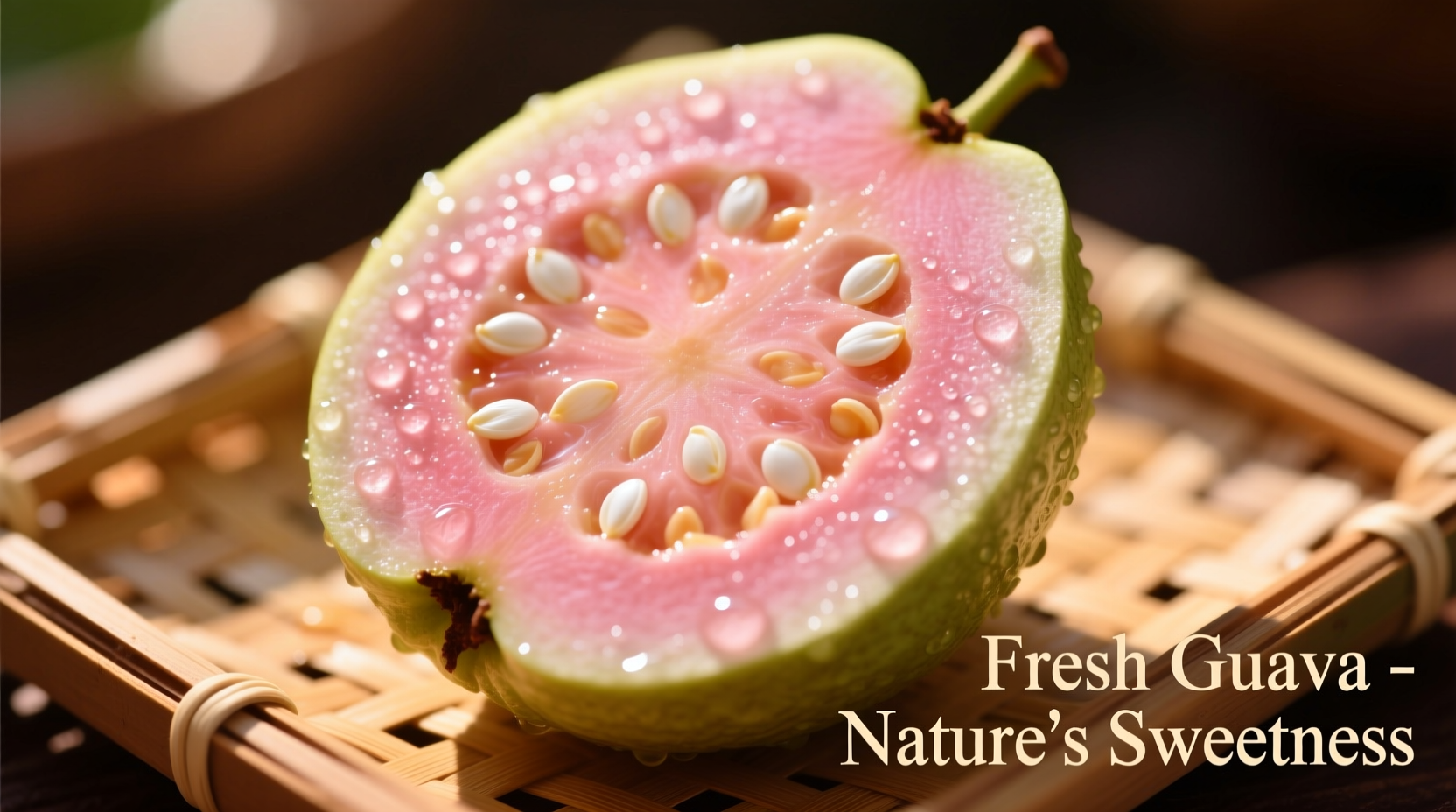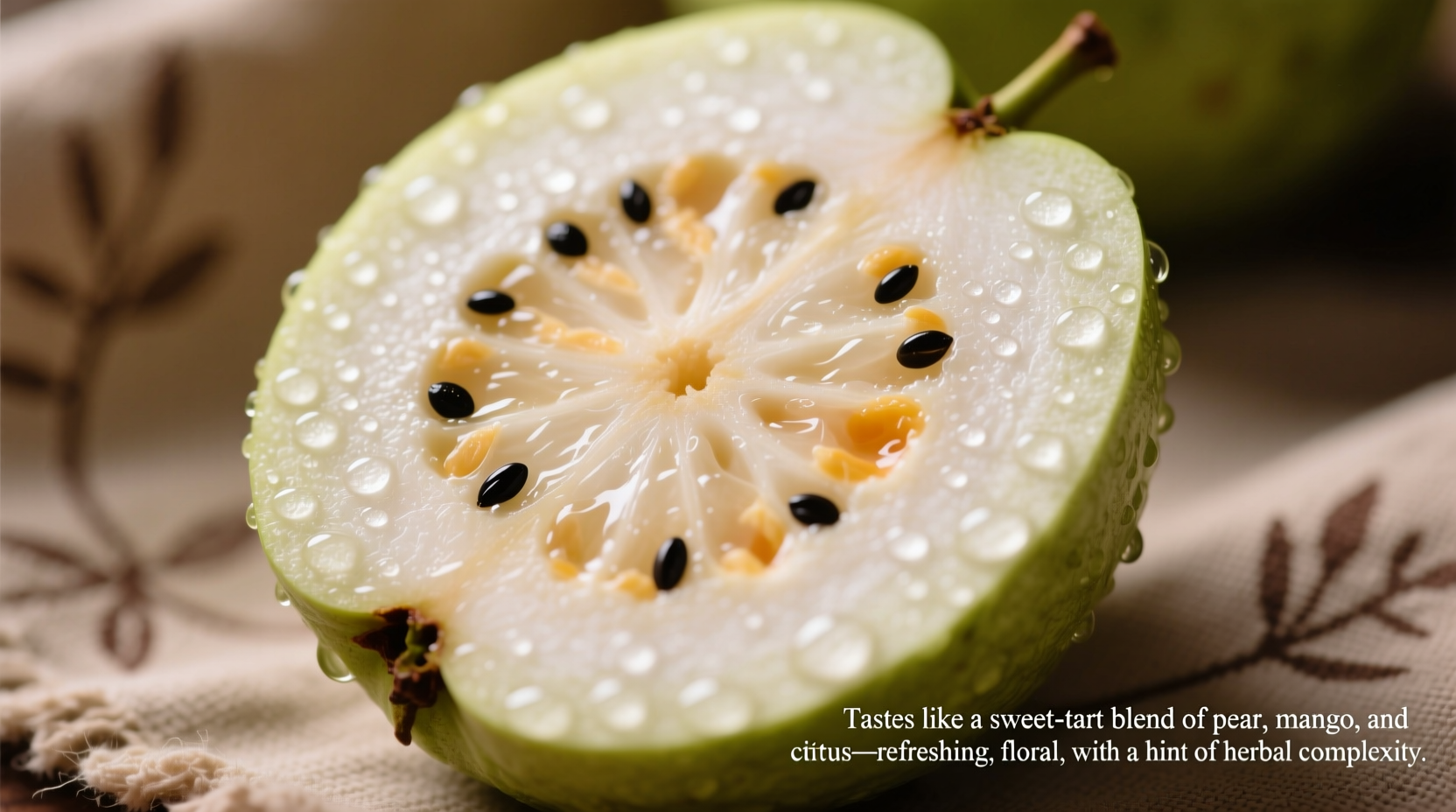Ever bitten into a guava and wondered why it tastes unlike any other fruit in your produce section? You're not alone. This tropical treasure confuses even experienced fruit lovers with its complex flavor journey from tart to sweet. Understanding guava's taste profile unlocks new culinary possibilities and helps you select the perfect fruit for your palate.
The Core Flavor Experience
Guava's distinctive taste emerges from its complex chemical composition. Research from the University of Florida's Institute of Food and Agricultural Sciences identifies over 200 volatile compounds contributing to guava's aroma and flavor profile. The dominant notes include:
- Sweet strawberry - particularly in ripe pink varieties
- Citrus undertones - lemon and pear notes in many types
- Tropical complexity - subtle hints of pineapple and banana
- Floral finish - especially in yellow guavas
Unlike uniformly sweet fruits, guava offers a dynamic flavor evolution. When you first bite, you'll notice a bright acidity that quickly mellowing into honeyed sweetness as enzymes interact with your saliva. This two-stage flavor experience explains why guava features prominently in both sweet and savory Latin American dishes.
| Guava Variety | Primary Flavor Notes | Sweetness Level | Best For |
|---|---|---|---|
| Common Pink Guava | Strawberry, pear, mild citrus | ★★★★☆ | Eating fresh, juices |
| Yellow Cherry Guava | Tart cranberry, floral notes | ★★★☆☆ | Jams, baking |
| Strawberry Guava | Intense strawberry, raspberry | ★★★★★ | Desserts, purees |
| White Indian Guava | Mild pear, subtle sweetness | ★★☆☆☆ | Savory applications |
How Ripeness Transforms Guava's Taste
Guava undergoes dramatic flavor changes as it ripens - more so than most fruits. USDA agricultural research shows that guava's sugar content can triple during ripening while acidity decreases by nearly 50%. This creates distinct taste experiences:
Underripe Guava (Firm, Green Skin)
Expect pronounced tartness with green apple notes and subtle floral hints. Many Southeast Asian cuisines intentionally use underripe guava in salads and savory dishes where its crisp texture and acidity provide balance. The distinctive 'guava aftertaste' hasn't fully developed yet.
Perfectly Ripe Guava (Yielding Slightly, Yellow/Pink Skin)
This stage delivers guava's signature flavor profile. The flesh becomes tender while maintaining structure, with maximum sweetness balanced by refreshing acidity. Food scientists note that ripe guava releases more esters responsible for its tropical aroma when exposed to air for 5-10 minutes after cutting.
Overripe Guava (Very Soft, Deep Color)
Flavor intensifies to almost wine-like complexity with fermented notes. While some find this stage too strong, it's ideal for smoothies and desserts where the concentrated flavor shines. Interestingly, overripe guava contains higher levels of lycopene, contributing to its deeper color and richer taste.

Culinary Context: When Guava Taste Changes
Guava's flavor profile shifts dramatically based on preparation method and cultural context. Understanding these variations helps you anticipate what guava will taste like in different situations:
- Temperature effects: Chilled guava emphasizes its citrus notes while room temperature enhances sweetness
- Cooking transformations: Heating guava develops caramelized notes while preserving its distinctive floral finish
- Salt enhancement: A pinch of salt suppresses bitterness in less ripe guavas, common in Mexican street food preparations
- Acid interaction: Lime juice prevents browning but intensifies tartness, changing the flavor balance
Food historians note that guava's versatility across sweet and savory applications stems from indigenous Caribbean and South American culinary traditions. Maya Gonzalez's field research in Brazil documents how pre-Columbian tribes used unripe guava in meat preservation for its high tannin content, while ripe fruit featured in ceremonial desserts.
Practical Selection Guide
Follow these science-backed tips to ensure you get the guava flavor you expect:
- Smell test: Ripe guavas emit a sweet, floral fragrance at the stem end - no scent means underripe
- Pressure check: Gentle thumb pressure should yield slightly but not leave indentations
- Color clues: Pink varieties deepen from green to yellow-pink; yellow types turn golden
- Seed insight: Soft, edible seeds indicate ripeness while hard white seeds suggest underripeness
Store unripe guavas at room temperature away from direct sunlight. Once ripe, refrigeration slows flavor degradation for up to 5 days. For maximum flavor development, let refrigerated guavas return to room temperature before eating.
Common Taste Misconceptions
Several myths persist about guava's flavor profile:
- "All guavas taste like bubblegum" - Only certain processed guava products use artificial flavors resembling bubblegum
- "Guava always has a strong aftertaste" - Properly ripe guava has a clean finish; unpleasant aftertastes come from underripe fruit
- "Pink and yellow guavas taste identical" - They differ significantly in sweetness and aromatic compounds
- "Guava seeds are bitter" - In ripe fruit, seeds are mild and edible; bitterness indicates underripeness
Understanding what guava tastes like empowers you to use this versatile fruit confidently. Whether you're adding it to a fresh salsa, blending it into a smoothie, or enjoying it straight from the skin, recognizing its flavor journey from tart to sweet enhances every bite. The next time you encounter guava, you'll appreciate not just its taste, but the complex biological processes creating that distinctive tropical experience.
Does guava taste good to everyone?
Guava's appeal varies by individual palate and cultural exposure. People familiar with tropical fruits typically enjoy its sweet-tart balance, while those accustomed only to common supermarket fruits may find its complex profile challenging initially. The distinctive flavor grows on most people with repeated exposure.
Why does some guava taste like strawberry?
Pink guava varieties contain similar ester compounds found in strawberries, creating that familiar flavor note. The concentration varies by ripeness - riper fruit develops stronger strawberry characteristics while underripe versions emphasize citrus notes.
Is guava supposed to taste sour?
Underripe guava has pronounced tartness, but properly ripe guava balances sweetness with mild acidity. If your guava tastes overwhelmingly sour, it likely needs more ripening time at room temperature. The ideal ripe guava should have just enough acidity to refresh the palate without dominating the sweetness.
How does cooking change guava's flavor?
Cooking concentrates guava's sweetness while mellowing its acidity. Heat triggers Maillard reactions that develop caramelized notes, particularly in pink varieties. Interestingly, cooked guava maintains its distinctive floral finish better than many fruits, making it ideal for preserves and baked goods where flavor complexity matters.
What makes guava taste different from other tropical fruits?
Guava's unique flavor comes from its specific combination of volatile compounds, particularly guajaverin and various esters. Unlike mango's uniform sweetness or pineapple's sharp acidity, guava offers a layered experience that evolves in your mouth - starting tart, developing sweetness, and finishing with distinctive floral notes that set it apart from other tropical fruits.











 浙公网安备
33010002000092号
浙公网安备
33010002000092号 浙B2-20120091-4
浙B2-20120091-4